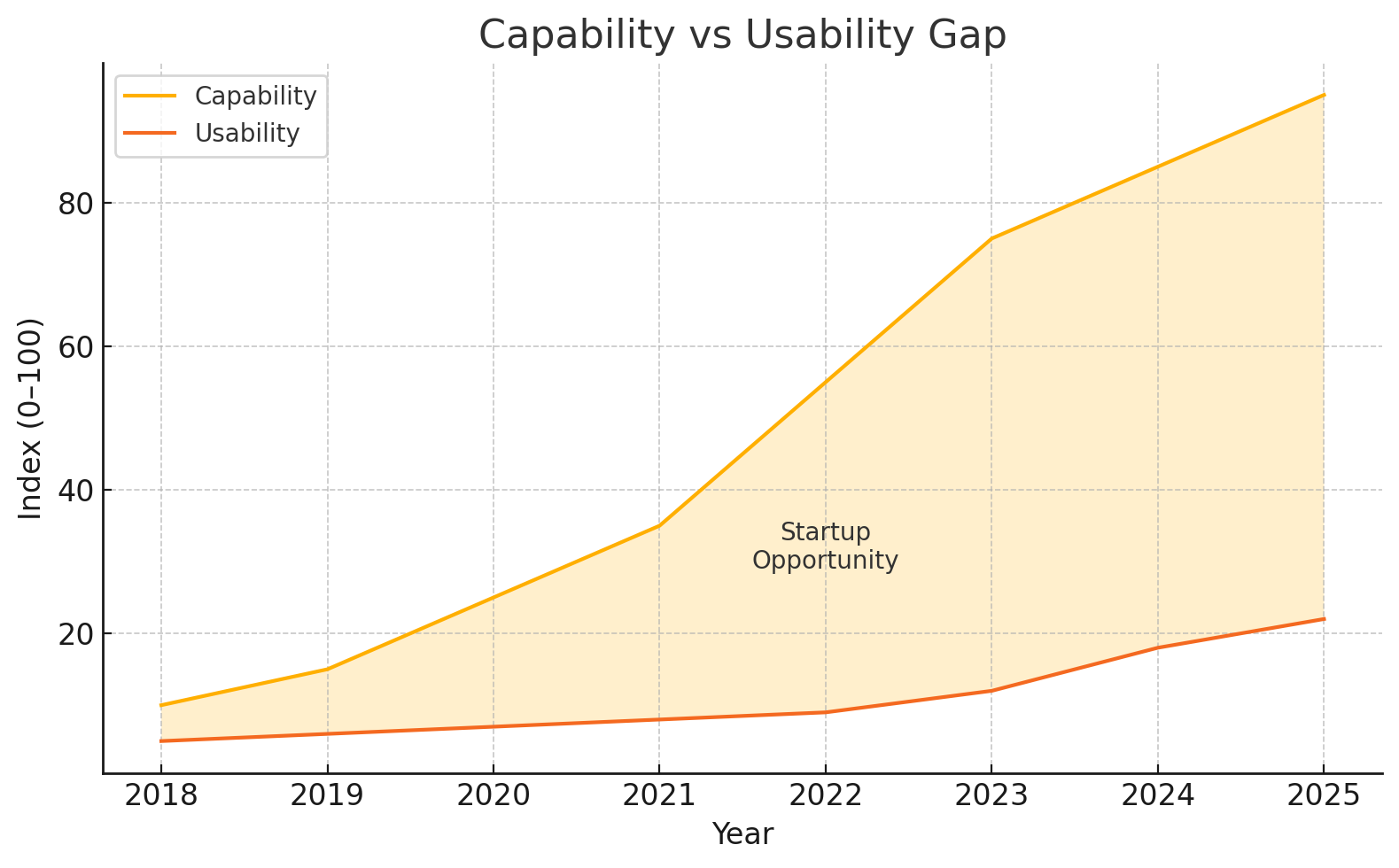Why ChatGPT’s Success Guarantees a Thousand Unicorns
Jun 01, 2025
Or: How the AI wars just created the biggest startup opportunity in history
TL;DR: AI power is compounding faster than usability. The resulting complexity gap is the best greenfield for vertical software since the spreadsheet.

Excel’s trick, in fast-forward
- 1985 Excel 1.0. Rows, columns, arithmetic.
- 1990 Charts and a macro recorder arrive.
- 1993 PivotTables and VBA land.
- 2000 Web queries and OLAP cubes make it enterprise-grade.
- 2010 Power Pivot handles big data.
- 2023–24 Python in Excel reaches general availability.
Every step boosted capability. Each step also widened the opening for companies that made one slice of work painless. Intuit, Salesforce, and ServiceNow now sit above 200 billion dollars each.
AI is replaying the same movie, only faster
- 2022 ChatGPT launches.
- 2023 GPT-4, plugins, Code Interpreter, vision and voice (beta).
- 2024 Custom GPTs and GPT-4o real-time voice.
- 2025 GPT-4.1 and the o-series raise accuracy and speed again.
Add Claude 4.0, Gemini 2.5, Grok 3, Llama, Mistral, DeepSeek, and every open-weight model. Capability explodes. Usability does not.
Choice explodes. Users freeze.
Whenever a new feature drops from an AI lab our Slack lights up. Half the team cheers. The rest worry we need to retrain a model by Friday or die. Customers feel the same tug-of-war.
A small-business owner wants last quarter’s sales insight.
Path 1 – wrestle the “Excels.”
Pick a platform. Pick a model. Toggle vision, code, voice, canvas. Write a prompt. Verify the answer.
Path 2 – click the “QuickBooks.”
Press “Sales Analytics.” View the dashboard. Move on.
Most people pick Path 2. I watched a research director type “healthcare” into ChatGPT and get a Wikipedia snippet. In our purpose-built investing tool the same word produced themed sub-sectors, orthogonality scores, and a draft portfolio. Spreadsheet versus QuickBooks, encore.
Each new feature births ten startups
OpenAI adds vision. Founders panic. Radiology QA, real-estate photo comps, fashion styling, and factory defect detection pop up.
Anthropic offers a 200 k token window. “Document AI is dead” tweets appear. Contract review, academic synthesis, massive codebase maps, and book-editing engines launch anyway.
Capability without domain context creates overwhelm. Overwhelm is the gap you fill.
Escape the model matrix
Write marketing copy. GPT-4.1 gives safe prose. Claude 4.0 nails tone. Gemini 2.5 is cheaper. Grok 3 pushes an edgy vibe. Users do not want to juggle that matrix. They want an answer. The product that hides model choice wins.
Steal Intuit’s four-step playbook
- Assume the domain.
- Embed the workflow.
- Strip needless options.
- Speak the user’s language.
A lawyer types “draft NDA.” Your backend calls Claude for the draft, GPT-4.1 for clause compliance, and a legal database for precedent. The user downloads a finished document, not a chat log.
The thousand-unicorn thesis
Stronger models bring messier choices. Messier choices push users toward products that erase the complexity. Five platforms, dozens of models, hundreds of feature flags, and infinite prompt tweaks. Chaos for them. A moat for you.
The future is not “ChatGPT kills software.” The future is “ChatGPT complexity births a thousand unicorns.”
Which one will you build?